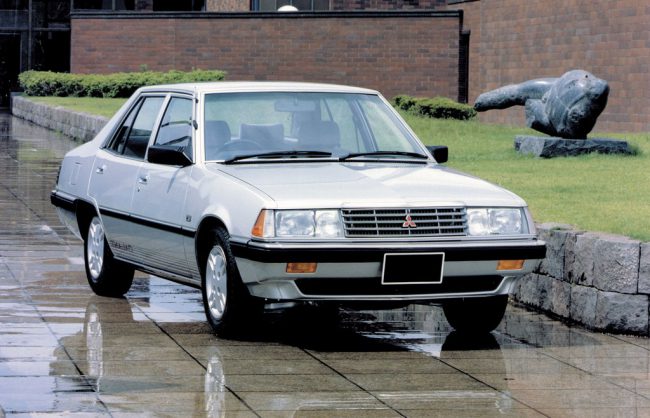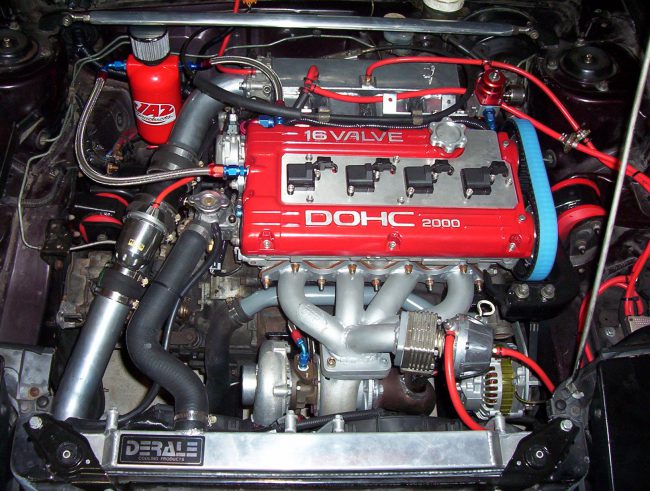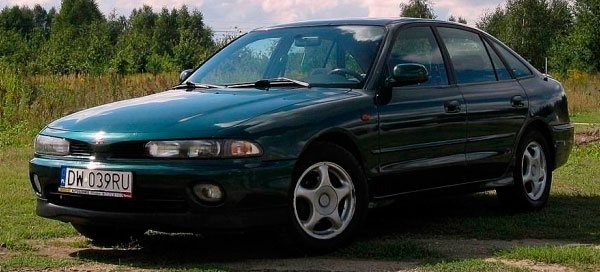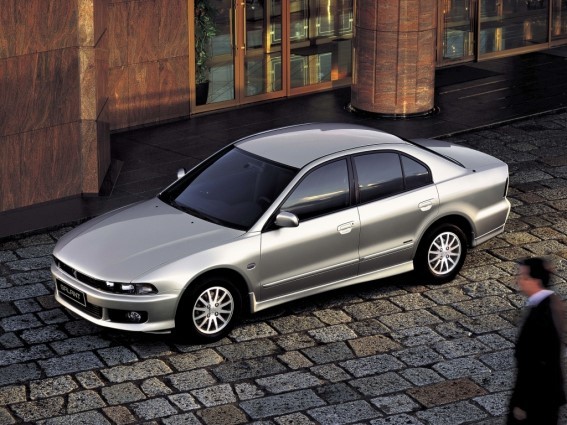
Mitsubishi Galant engines
Content
Mitsubishi Galant is a medium sized sedan. Mitsubishi Motors produced it from 1969 to 2012. During this time, 9 generations of this model were released.
Translated from English, the word Galant means "Knightly". Over the entire period of release, over five million copies of the Galant model have been sold. The first models were compact in size. Subsequently, the designers increased the size of the sedan to attract a different category of buyers.
Production of the first generation began in Japan, but since 1994, the supply of cars to the American market has come from a factory located in Illinois, which was formerly owned by Diamond-Star Motors.
First modification
December 1969 is the date when the first Mitsubishi Galant rolled off the assembly line. The buyer was offered a choice of 3 engine modifications: a 1,3-liter engine with the AI index, as well as two 1,5-liter engines with the AII and AIII indices. The first body was a four-door sedan, but a year later, Mitsubishi launched the Galant in hardtop and station wagon bodies, with two and four doors, respectively.  A little later, the designers introduced a version of the "Coupe" Colt Calant GTO, in which there was a limited-slip differential, as well as a 1.6-liter twin-shaft engine that developed 125 hp. The second modification of the coupe body appeared in 1971. Under the hood, he had a 4G4 gasoline engine, the volume of which was 1.4 liters.
A little later, the designers introduced a version of the "Coupe" Colt Calant GTO, in which there was a limited-slip differential, as well as a 1.6-liter twin-shaft engine that developed 125 hp. The second modification of the coupe body appeared in 1971. Under the hood, he had a 4G4 gasoline engine, the volume of which was 1.4 liters.
Second modification
Production of the second generation dates from 1973-1976. It received the A11* marking. Demand for these vehicles was almost double that of the first generation vehicles. Regular versions were equipped with a mechanical four-speed transmission, and sports versions were also equipped with a manual transmission, but with five gears. Individually, Mitsubishi installed a three-speed automatic. As a power plant, a 1.6 liter engine was mainly used, developing a power of 97 hp.
 Restyled versions of the second generation received a new power plant from Aston. It is capable of developing a power of 125 hp. at 2000 rpm. They used Mitsubishi's Silent Shaft technology, which was designed to reduce vibration and noise. These models were marked A112V and were sold as commercial vehicles in Japan. Models for New Zealand received a 1855 cc engine. They were assembled at the Tedd Motors factory.
Restyled versions of the second generation received a new power plant from Aston. It is capable of developing a power of 125 hp. at 2000 rpm. They used Mitsubishi's Silent Shaft technology, which was designed to reduce vibration and noise. These models were marked A112V and were sold as commercial vehicles in Japan. Models for New Zealand received a 1855 cc engine. They were assembled at the Tedd Motors factory.
Third modification
In 1976, the third generation of the car appeared, called the Galant Sigma. In the United States, it was sold under the Dodge Colt brand, and in Australia it was produced by Ghrysler. This generation was equipped with MCA-Jet engines, which were distinguished by increased environmental performance. This car was very much appreciated in the territories of South Africa and New Zealand.
Fourth Modification
May 1980 was the debut date for the fourth version of the Galant. They installed a completely new line of engines called Sirius. They also included diesel power units, which were installed in passenger cars for the first time. Gasoline engines began to be equipped with a new electronic system responsible for the timely injection of the fuel mixture.
 The Japanese automaker set a quota for the supply of cars to various countries, but the export of Australian models to the UK Galant Sigma was carried out thanks to a change in the name of the brand to Lonsdale. Compared with the third generation, the fourth modification cannot be called successful. There was no coupe body in the fourth generation; instead, the company restyled the previous model, which was sold until 1984.
The Japanese automaker set a quota for the supply of cars to various countries, but the export of Australian models to the UK Galant Sigma was carried out thanks to a change in the name of the brand to Lonsdale. Compared with the third generation, the fourth modification cannot be called successful. There was no coupe body in the fourth generation; instead, the company restyled the previous model, which was sold until 1984.
Fifth Modification
The all-new Mitsubishi Galant rolled off the assembly line at the end of 1983. For the first time, the car was equipped with front-wheel drive and suspension, in which the level of the body was automatically maintained thanks to electronic systems.
At this time, the company began producing versions intended for the American and European markets. For the market, American cars were equipped with 2.4-liter gasoline power plants, as well as 1.8-liter diesel units. Also for American markets, two more powerful engines were offered: a 2-liter turbocharged and a 3-liter gasoline engine, with six cylinders arranged in a V-shape.
Repairing such an engine and replacing its main parts is a very expensive procedure. For example, in order to remove the engine mount, it is necessary to disassemble a lot of engine elements, so this procedure takes a very long time. For the European market, four-cylinder carburetor engines were installed.
The volume of these engines was: 1.6 and 2.0 liters. In 1995, the car was awarded the German Das Goldene Lenkrad (Golden Steering Wheel) award. Also in 1985, cars began to be equipped with all-wheel drive. However, their release was limited, they were mainly installed cars that participated in rally races.
Sixth modification
This generation left the assembly line in 1987. In the same year, it was awarded as the best Car of the Year in Japan. In the United States, the car began to sell in 1989. In the sixth generation, there are several options for power plants.
The body with the E31 index was equipped with an eight-valve 4G32 power unit, the volume of which is 1.6 liters, as well as front-wheel drive. A 1.8-liter eight-valve petrol engine was installed in the front-wheel drive E32 model. The E4 body was equipped with an engine marked 63G33.
It is a two-liter unit with two or four valves per cylinder that drives the car's front wheels. Galant E34 became the first car of the sixth generation, which was equipped with a 4D65T diesel engine with a volume of 1.8 liters. It could be installed with a choice of front-wheel drive or all-wheel drive. The body of the E35 was front-wheel drive and came only with a 1.8-liter 16-valve gasoline engine.
The E37 body was equipped with a 1.8-liter 4G37 engine with 2 valves per cylinder and a 4x4 wheel arrangement. It was possible to buy the E38 model only with a two-liter 4G63 engine and all-wheel drive.  This 4G63 engine was also installed in the E39 model with an updated 4WS all-wheel drive system, which could also be equipped with a turbine. The release of all modifications was carried out both in the sedan and in the hatchback. The only model in which air suspension was installed is a body marked E33.
This 4G63 engine was also installed in the E39 model with an updated 4WS all-wheel drive system, which could also be equipped with a turbine. The release of all modifications was carried out both in the sedan and in the hatchback. The only model in which air suspension was installed is a body marked E33.
There is an experimental model of the sixth generation in the back of the E39. Its difference is complete controllability: The control unit rotates the rear wheels at a small angle using a hydraulic mechanism. The power of the two-liter modified 4G63T engine was 240 hp.
This version from 1988 to 1992 successfully participated in the international rally. Mitsubishi Galant Dynamic 4 is the forerunner of the legendary Lancer Evolution.
Restyling, which took place in 1991, included: updating the front and rear bumpers, installing a chrome grille and plastic lining on the surface of the front fenders and doors. The color of the optics has also changed from white to bronze. This car became the basis for the creation of the Mitsubishi Eclipse model.
Seventh modification
The debut took place in May 1992. The release was carried out in bodies: sedan and liftback with five doors. However, only the sedan version reached the American market. In connection with the advent of the Mitsubishi Lancer Evolution model, Galant has lost a little of its sportiness. The four-cylinder engine was replaced by a two-liter engine in which the cylinders are arranged in a V-shape. They worked in conjunction with the previous generation all-wheel drive transmission.
In 1994, the United States began to produce an improved version of the engine, labeled Twin Turbo. Now he developed 160 hp. (120 kW). Among the innovations are the installation of parametric steering, a rear stabilizer bar and the possibility of installing a manual transmission.
Eighth modification
This car is the most popular among all models from this line. It has a beautiful, sporty design, thanks to which it has attracted a large number of buyers. His appearance earned him the nickname "The Shark". Two years in a row 1996-1997 he was recognized as the car of the year in Japan.
There are two body types in which the eighth generation was produced: sedan and station wagon. The sports version of VR was equipped with a new 2.5 liter engine with 2 turbocharged compressors. The cylinders in it are arranged in a V-shape. Such a motor is capable of developing a power of 280 hp. In 1996, the production of cars with GDI engines began. Their difference is the presence of a direct fuel injection system. For long engine operation, it is important to fill in high-quality engine oil.
Galant 8 cars were supplied to 4 main markets: Japanese, Asian, European, American. The European and Japanese markets were supplied with cars with the same equipment, but with different power plants. Europeans received a multi-link suspension and could choose engines with a volume of 2 to 2.5 liters.  The Asian version has an electronically controlled carburetor. The American version differs in the design of the front panel and interior elements. The American was equipped with two engines: a 2.4 liter 4G64 engine with a power of 144 hp. and a 3-liter V-shaped power unit 6G72, developing a power of 195 hp. Metal engine protection was necessarily installed for this motor, since all its elements are expensive products. The end of the production of the car for the foreign market came in 2003.
The Asian version has an electronically controlled carburetor. The American version differs in the design of the front panel and interior elements. The American was equipped with two engines: a 2.4 liter 4G64 engine with a power of 144 hp. and a 3-liter V-shaped power unit 6G72, developing a power of 195 hp. Metal engine protection was necessarily installed for this motor, since all its elements are expensive products. The end of the production of the car for the foreign market came in 2003.
In American cars, the GDI direct fuel injection system was not installed. For the domestic, Japanese market, the car was produced until 2006 with a two-liter power unit with a capacity of 145 hp. running on the GDI system.
Ninth modification
The latest generation was produced between 2003 and 2012. These cars were produced only in a sedan. Two modifications DE and SE were equipped with four-cylinder gasoline engine units with a volume of 2.4 liters and a power of 152 hp. The GTS model is capable of delivering 232 hp. thanks to the V-shaped six-cylinder power plant. The most powerful modification marked Ralliart had a volume of 3.8 liters.
 The cylinders are arranged in a V-shape. Such a motor developed 261 hp. power. Unfortunately, the car reached the Russian market only with a 2.4-liter 4G69 engine. Since 2004, the assembly of the modified ninth generation has been carried out in Taiwan. The cars produced at this plant were labeled Galant 240 M. They were equipped with a 2.4 engine with a variable valve timing system MIVEC.
The cylinders are arranged in a V-shape. Such a motor developed 261 hp. power. Unfortunately, the car reached the Russian market only with a 2.4-liter 4G69 engine. Since 2004, the assembly of the modified ninth generation has been carried out in Taiwan. The cars produced at this plant were labeled Galant 240 M. They were equipped with a 2.4 engine with a variable valve timing system MIVEC.
The ninth generation was not in high demand among buyers. The president of the automotive giant Mitsubishi Motors in 2012 decided to discontinue the production of this model. All efforts were directed to the production of more successful Lancer and Outlander models.
Operation Features
Quite often, the owners of these cars complain about an unreadable engine number, which creates problems when reissuing a car. In general, Mitsubishi engines are reliable units. The price of a contract engine starts on average from 30 rudders. In cold regions, problems arise with starting the engine, as well as with the stove motor. The first malfunction is often helped by the installation of a heating boiler.
To solve the second problem, it is necessary to replace the heater electric motor, which fails due to increased load. The weakest suspension element is the ball bearings of the front steered wheels. Often the owners of the seventh generation troit the engine. In this case, it is necessary to check the ignition system. Each specialized center engaged in engine diagnostics and repair has a diagram of this mechanism.

